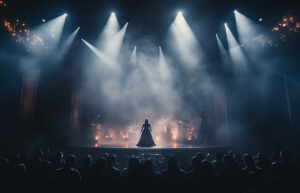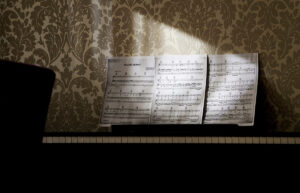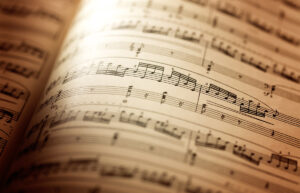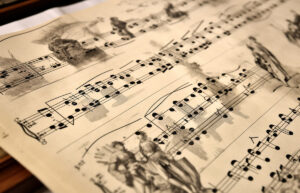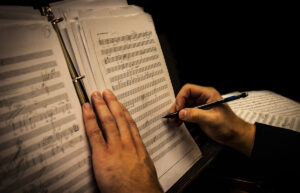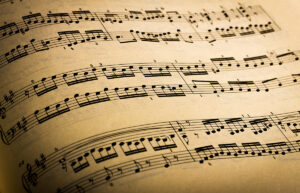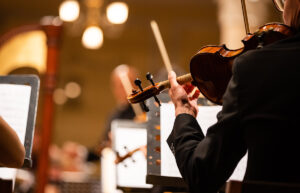What is a Fugue in Music: Meaning, Types, Terms, Structure & Composers

Step into the enchanting realm of fugue, a musical maze where themes intertwine harmoniously. Picture a dialogue of voices weaving melodies into a captivating tapestry. Join us on a journey to uncover the secrets of this compositional marvel, embraced by masters like Bach. Explore the essence of what is a fugue in music, its layers, imitations, and mesmerizing counterpoint.
Welcome to TheDemoStop, now join the community!
Connect with artists, fans and producers around the world.
What is a fugue in music?
A fugue in music is a contrapuntal technique where a theme (the subject) is introduced, then imitated and developed by other voices or instruments. This structured interplay involves multiple melodic lines overlapping in a harmonious yet complex manner.
Fugues are characterized by their intricate use of imitation, counterpoint, and strict compositional rules, resulting in remarkable depth and complexity compositions.
Origins and history of fugues
The fugue, a captivating musical form, has intrigued everyone since its inception during the Baroque period. Originating in the late 16th and early 17th centuries, it drew from contrapuntal techniques explored in vocal genres like motets and ricercari.
Composers like Johann Sebastian Bach elevated the form to unprecedented heights, as evidenced in his monumental work “The Well-Tempered Clavier,” showcasing its expressive power across various keys. Throughout history, the fugue persisted, adapting to changing stylistic preferences, even finding a place in the Romantic period, where composers like Brahms experimented with its structure.
In the 20th century, it continued to influence composers, adapting to avant-garde styles. Today, the fugue remains a significant part of musical education, inspiring contemporary composers and underscoring its enduring legacy across centuries. This rich history illuminates what is a fugue in music, showcasing its evolution and lasting impact on musical composition.
Types of fugues
Simple fugue
Simple fugues represent the foundational form of what is a fugue in music. They commonly feature a subject or theme introduced and then elaborated upon by various voices or instruments throughout the composition. Structurally, simple fugues begin with an exposition, where the subject is presented, followed by episodes that explore different musical ideas. The subject is then restated in subsequent sections, often in different keys and with variations, adding depth and complexity to the composition.
Double (triple, quadruple) fugues
Double fugues incorporate multiple subjects or themes; each is introduced separately before being combined to create a more intricate composition. Double fugues feature two distinct subjects presented separately before appearing together, while triple and quadruple fugues include three or four subjects, weaving them together in a complex manner.
Counter fugue
A counter fugue is a distinct type where the subject enters initially in inversion or augmentation rather than the original voice. This inversion presents a contrapuntal challenge for the composer, adding complexity and interest to the overall fugue.
Permutation fugue
In a permutation fugue, the subject undergoes variations such as inversion, augmentation, diminution, or retrograde (backwards) transformations. These alterations of the subject provide diverse thematic material throughout the composition, showcasing the composer’s skill in manipulating musical elements and elucidating the essence of what is a fugue in music.
Fughetta
A fughetta is a shorter, more condensed version of a fugue. It retains the fundamental elements of a fugue but on a smaller scale, usually with a simpler structure involving fewer voices and a shorter development of the subject.
Technical terms of fugue in music
Voices
In a fugue, “voices” refer to the independent musical lines or parts that present and develop the thematic material. Each voice carries a distinct melodic line and contributes to the contrapuntal texture of the composition. In traditional fugues, the voices can be performed by different instruments or sung by different vocal parts (soprano, alto, tenor, bass), and they interact by imitating and intertwining the main subject.
Subject
The “subject” is the primary musical theme or idea upon which the answer to what is a fugue in music lies. It’s the foundational motif that appears at the beginning of the composition in one voice and serves as the focal point for imitation throughout the piece. The subject is typically memorable and distinctive, recurring in various keys and undergoing transformations while maintaining its core identity.
Answer
The “answer” is the imitation of the subject presented in another voice after its initial appearance.
There are two types of answers: real and tonal. A real answer closely mirrors the intervals and melodic shape of the subject, while a tonal answer maintains the contour but adjusts some intervals to fit the harmony of the new key.
Countersubjects
The “countersubject” is a secondary theme that accompanies the subject and answer throughout the fugue. It contrasts with the main subject, usually appearing simultaneously with the subject in another voice.
The countersubject provides harmonic and rhythmic contrast, serving as a complementary element to the subject and contributing to the intricate interplay between voices in the fugue’s texture.
Welcome to TheDemoStop, now join the community!
Connect with artists, fans and producers around the world.
Structure of a fugue
Exposition
The exposition is the initial section of a fugue where the main thematic material is introduced. It typically includes the presentation of the subject and, in some cases, the answer. During the exposition, each voice sequentially presents the subject or its answer, establishing the main themes of the fugue. This section ends once all voices have entered with the subject or answer.
Episode
Following the exposition, episodes occur between restatements of the subject or answer. Episodes are transitional passages that provide contrasts or modulation, often exploring harmonic or melodic material derived from the main themes. They serve to modulate between different keys, connect various statements of the subject, and create tension and release within the fugue’s structure.
Development
The development section elaborates and transforms the subject, answer, and related motifs. Composers manipulate these themes by altering their rhythm, texture, intervals, and other musical elements. This section showcases the composer’s creativity in exploring different variations, inversions, and transformations of the initial thematic material.
Final section
The final section of a fugue brings the composition to its resolution. This section often includes a restatement of the subject in the original key (or tonic) and may incorporate elements from the exposition. It serves to bring the fugue to a satisfying conclusion, often emphasizing the main themes and providing a sense of closure to the musical journey established throughout the composition.
Famous fugues and composers
“Toccata and Fugue in D minor” by Johann Sebastian Bach
This iconic composition features a dramatic and virtuosic Toccata followed by a powerful Fugue. The fugue section is known for its intricate counterpoint and majestic themes, showcasing Bach’s mastery of the form. While its exact purpose and date of composition remain debated, it has become one of Bach’s most recognized and celebrated works, often associated with the organ repertoire.
“Grosse Fuge” by Ludwig Van Beethoven
Originally composed as the final movement of Beethoven’s String Quartet No. 13, Op. 130, the “Grosse Fuge” (Great Fugue) is a monumental work known for its complexity and intensity. Beethoven’s fugue pushes the boundaries of traditional fugue writing with its bold and innovative harmonic language, creating a profound and emotionally charged piece that bewildered audiences at the time with its avant-garde nature.
“Fugue in A major” by Dmitri Shostakovich
Shostakovich’s Fugue in A major, part of his Prelude and Fugue cycle for piano, showcases his skilful use of the fugue form within a set of 24 preludes and fugues. This fugue is marked by its contrapuntal intricacy and emotional depth, reflecting Shostakovich’s unique musical voice and his ability to blend traditional forms with modern harmonic language.
“Requiem in D Minor” by Wolfgang Amadeus Mozart
While Mozart’s “Requiem” is primarily known as a choral masterpiece for its profound settings of the Requiem Mass text, it also contains fugues within certain movements, notably the “Kyrie” and “Cum Sanctis Tuis .” These fugues within the larger choral work demonstrate Mozart’s compositional versatility, combining the Requiem Mass’s solemnity with the fugue form’s intricate textures.
Conclusion
What is a fugue in music?
A fugue in music is a contrapuntal composition where a main theme (called the subject) is introduced and successively developed by multiple voices or instruments through imitation, creating intricate interplay and harmony.
Origins and history of fugue
The fugue originated from Renaissance polyphony, evolving into a structured form during the Baroque era. Composers like Johann Sebastian Bach elevated it to prominence, demonstrating its complexity and enduring significance in Western classical music.
Types of fugues
- Simple fugue
- Double (triple, quadruple) fugue
- Counter fugue
- Permutation fugue
- Fughetta
Technical terms of fugue in music
- Voices
- Subject
- Answer
- Countersubjects
Structure of a fugue
- Exposition
- Episode
- Development
- Final section
Famous fugues and composition
- “Toccata and Fugue in D Minor” by Johann Sebastian Bach
- “Grosse Fuge” by Ludwig van Beethoven
- “Fugue in A Minor” by Dmitri Shostakovich
- “Requiem in D Minor” by Wolfgang Amadeus Mozart
FAQs
What is a fugue in music?
A fugue in music is a complex contrapuntal composition. It’s based on a recurring theme that’s imitated and developed by different voices or instruments.
What is the history of fugues?
Fugues trace back to Renaissance polyphony but reached their peak during the Baroque era, notably in Johann Sebastian Bach’s works like “The Well-Tempered Clavier.” Bach’s mastery solidified the fugue as a cornerstone of Baroque music, influencing composers across subsequent centuries.
What are the different types of fugues?
- Simple fugue
- Double (triple, quadruplet) fugue
- Counter fugue
- Permutation fugue
- Fughetta
What is the structure of a fugue?
- Exposition
- Episode
- Development
- Final section
What are the technical terms of fugue in music?
- Voices
- Subject
- Answer
- Countersubjects
Who are the famous fugue composers?
- Johann Sebastian Bach
- Ludwig van Beethoven
- Dmitri Shostakovich
- Wolfgang Amadeus Mozart
What is a simple fugue?
A simple fugue is a basic form of contrapuntal composition. It features a single theme developed across multiple voices or instruments.
What is a counter fugue?
A counter-fugue is a type of fugue where the subject initially enters in inversion or augmentation. This addition adds complexity to the composition’s contrapuntal structure.
What is a permutation fugue?
A permutation fugue involves variations of the subject through techniques like inversion, augmentation, or retrograde. These variations create diverse thematic material within the composition.
Which is the most famous fugue?
Johann Sebastian Bach’s “Toccata and Fugue in D minor” stands out as among the most famous and recognizable fugues.















